Centaur, Satyr, Minotaur and more! The new races and subclasses in Mythic Odysseys of Theros, the latest D&D sourcebook
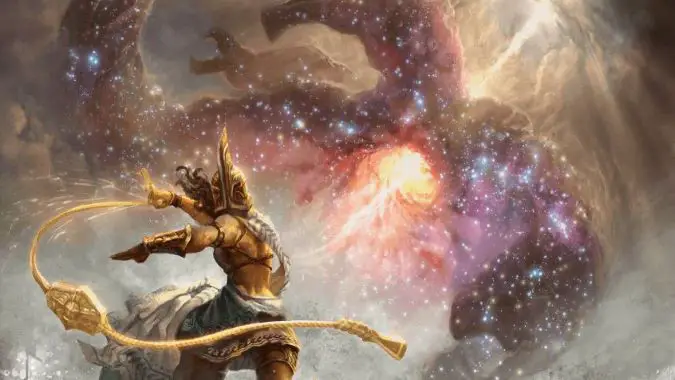
The new Dungeons and Dragons sourcebook, Mythic Odysseys of Theros, has just launched on D&D Beyond, with print editions coming in July. This is a Greek Mythology inspired setting crossed over with the magical pseudo-medieval setting of the original. In this new land, familiar D&D races like Elves, Dwarves, and Half-Orcs don’t exist. In their place, a number of new — or existing-but-redesigned — races are there for players to add to their campaign. Additionally, two new subclasses have been added: College of Eloquence for Bard, and Oath of Glory for Paladin.
Let’s take a closer look at the races and subclasses you can find in this new sourcebook.
New races in Mythic Odysseys of Theros
All of the new races are true to their Greek myths in appearance and influence. Would the original Minotaur team up with a roaming group of adventurers? Is a humanoid lion new to D&D? No, but this is a new take on these concepts, while keeping true to the origins of their myths. Here is a summary of what each brings as a playable race. The starting Ability Score does not have to determine which class they are best suited for, but for some players, that does influence choice.
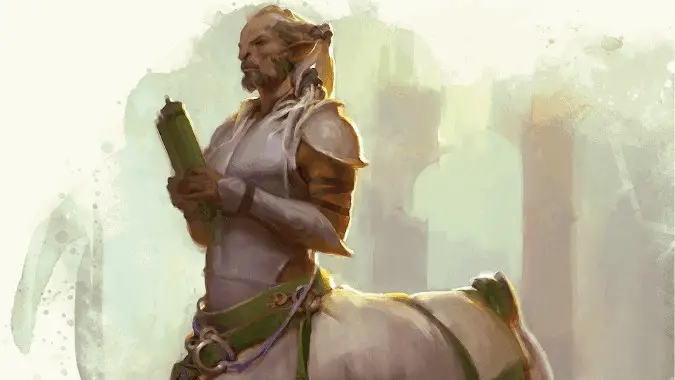
Centaur
Humanoid from the waist up, horse from the waist down. This was taken into consideration when determining their abilities. Walking speed is 40 feet, and their hooves can be used as a melee weapon. They have a built in charge attack, so if they move at least 30 feet towards their target, they can immediately attack with their hooves as a bonus action. Their equine body means they have increased carrying capacity, the way a mount allows players to carry more — as all Dungeon Masters are strict about how much weight a player can carry. The body and hooves also mean they have trouble climbing, and they have a penalty to climbing speed. They have a starting Ability Score Increase of Strength +2, and Wisdom +1.
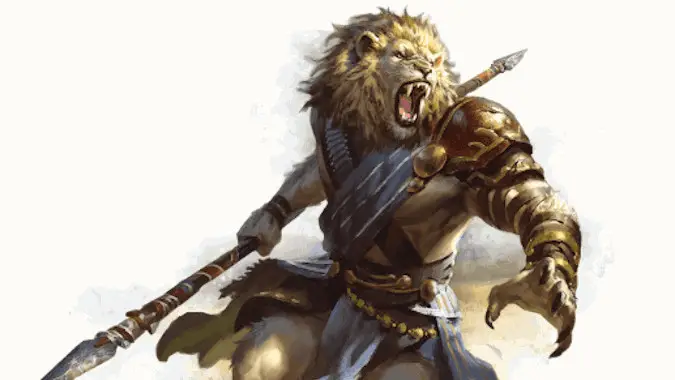
Leonin
These are not Tabaxi; these lion humanoids stand as their own race. They are loners, wanderers, out there on the plains, avoiding others, who will only begrudgingly join a party due to necessity. They are quick stalkers, with a walking speed of 35 feet, and innate Darkvision. They have a built-in weapon with their Claws, an unarmed attack that deals slashing damage, increased by their Strength modifier. And they are lions, so of course they have a ferocious roar. As a bonus action, they can do a roar that frightens creatures of their choice. They have a starting Ability Score Increase of Constitution +2, and Strength +1.
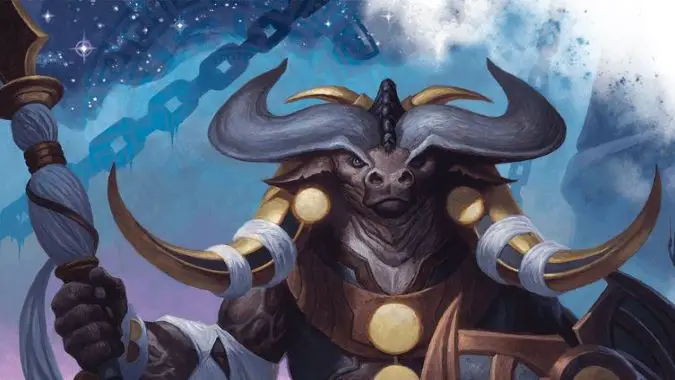
Minotaur
Humanoid bulls. Some seek to slaughter those who put down their race for ages, others know they are accepted in society. They are all about their horns. Horn attack is an unarmed attack that does piercing damage, plus their Strength modifier. If they Dash, they can use their horn attack as a bonus action. When they attack, they can shove a creature with their horns and move them 10 feet. Also, they have proficiency with Intimidation or Persuasion, probably because of the horns. They have a starting Ability Score Increase of Strength +2, and Constitution +1.
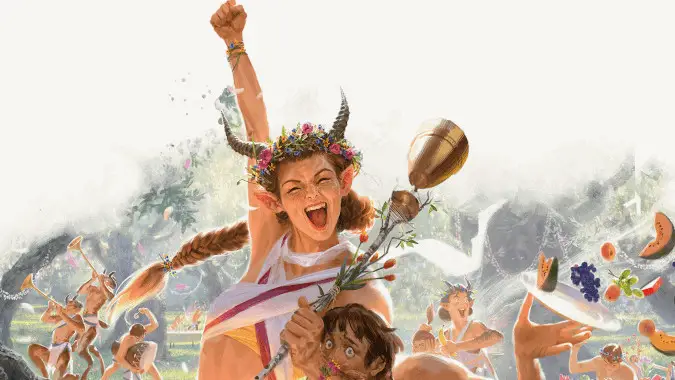
Satyr
Humanoids, shorter, with goat-like horns, pointed ears, legs covered in fur, and hooves. They don’t take life as serious as others, and believe it should be enjoyed. Their walking speed is 35. They can use their horns to ram a target, a bludgeoning attack with their Strength modifier, like the other races so far, but they don’t start with a Strength bonus. They have advantage on saving throws against spell and magical effect, a fairly powerful racial bonus as it doesn’t specify a particular kind of magic. Satyrs also gain a bonus of an eight sided dice — a d8 — to long or high jumps. They have a starting Ability Score Increase of Charisma +2, and Dexterity +1.
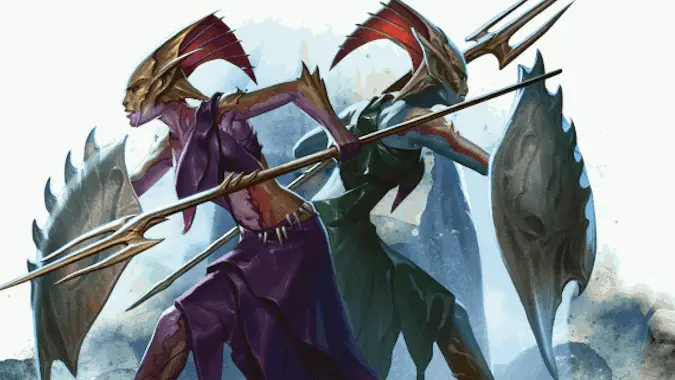
Triton
An amphibious race, they have fins and legs, more comfortable underwater, but able to hold their own on land among the “dryfolk.” They have a walking and swimming speed of 30 feet. Originating from the sea, they have a magical connection to control air and water, and have certain spells granted to them as a feat. From level 1 they can cast Fog Cloud. At level 3 they learn Gust of Wind. And at level 5 they learn Wall of Water. Their eyes have adjusted to the low light of the depths, giving them Darkvision. Tritons can communicate to aquatic creatures, giving simple ideas to beasts that breathe water. From living in the icy seas, they also have resistance to cold damage. They have a starting Ability Score Increase of Strength, Constitution, and Charisma +1.
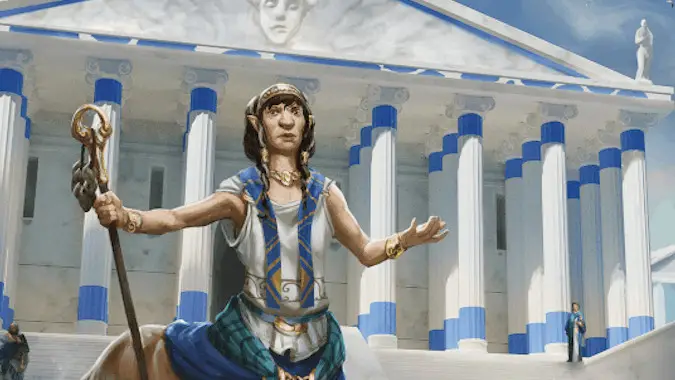
New subclasses in Mythic Odysseys of Theros
Two new subclasses were added, one for Bard, one for Paladin. To go with the Greek theme, the Bard was given the role of an actor on stage, a performer to pluck at the heartstrings to reach the emotions of the audience. The Paladin is the Greek hero. The champion who is part of a group, but who stands out as the one remembered as the greatest among them, for whom the tales are told.
Bard: College of Eloquence
This is a very straightforward subclass, with the theme of talking, inspiring, and trying to reach as many people as possible. The 14th level feature really makes great use of Bardic Inspiration. This wants the player to max out Charisma to make full use of this. The following are the features granted to this subclass.
- Silver Tongue — 3rd-level feature. A Persuasion or Deception check roll of 9 or lower is considered to be a 10.
- Unsettling Words — 3rd-level feature. As a bonus action, expend a use of Bardic Inspiration, roll the Bardic Inspiration die. A creature of your choosing must subtract that roll from their next saving throw.
- Unfailing Inspiration — 6th-level feature. When a creature adds one of your Bardic Inspiration dice, and the roll fails, the creature can keep the Bardic Inspiration die.
- Universal Speech — 6th-level feature. Choose a number of creatures, up to your Charisma modifier, they can understand you, regardless of what language they speak, up to one hour.
- Infectious Inspiration — 14th-level feature. When someone succeeds on a roll using a Bardic Inspiration, use a reaction to give someone else Bardic Inspiration, without expending any Bardic Inspiration uses. You can do this a number of times equal to your Charisma modifier.
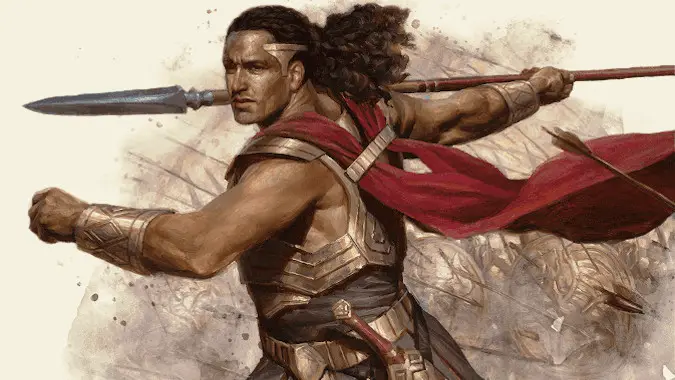
Paladin: Oath of Glory
A Paladin who takes this oath strives towards glorious deeds, facing hardships with allies, and heroics that will make them a legend. They also get a lot of spells, too many to list here. Additionally, they have the following features to make them the legendary heroes they are meant to be.
- Channel Divinity – Peerless Athlete — 3rd-level feature. As a bonus action, gain advantage on Athletic and Acrobatic checks and increase the distance of long and high jumps by 10 feet, for 10 minutes.
- Channel Divinity – Inspiring Smite — 3rd-level feature. After dealing damage with Divine Smite, use a bonus action to give temporary hit points to creatures of your choosing, including yourself.
- Aura of Alacrity — 7th-level feature. Increase the movement speed of yourself, and any ally within 5 feet of you, by 10 feet. Can include any ally within 10 feet of you at level 18.
- Glorious Defense — 15th-level feature. As a reaction, add your Charisma modifier to a creature’s Armor Class when that creature is attacked. If that attack misses, and your weapon can reach the attacker, you may then attack that attacker.
- Living Legend — 20th-level feature. As a bonus action, for 1 minute, gain advantage on all Charisma checks, make missed attacks hit instead, and reroll a failed saving throw.
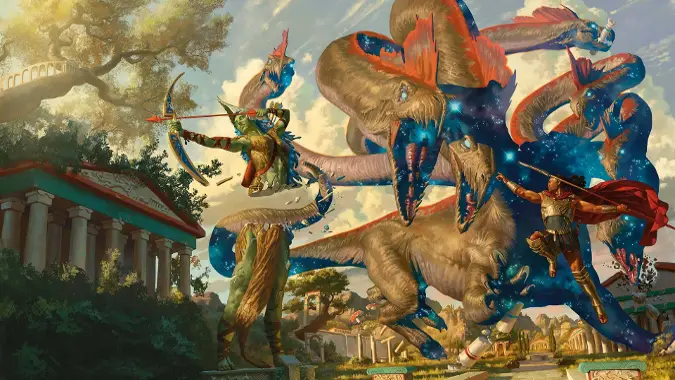
More to come from Mythic Odysseys of Theros
Here we have the starting information, to put the characters together. The races represent the world, capturing symbols of Greek Mythology, not simply making them mindless monsters, but playable people. These themes have come up in D&D before, but now they are fully realized, in a land fitting the lore. Paladin and Bard were not expanded on heavily with these two subclasses, but there is a slight variation on each that will have their niche.
But there is so much more to Theros yet to talk about. There are little things, like the new background, Athlete, to remind us of the Olympics and their Greek heritage. And larger things, like a whole list of monsters inspired by Greek mythology and Magic: The Gathering. Locations above and below the water, realms of mortals, of gods and goddesses. And then an entire pantheon of deities. There is also the question, why did D&D team up with M:TG, and will this continue, or will there be other crossovers?
Please consider supporting our Patreon!
Join the Discussion
Blizzard Watch is a safe space for all readers. By leaving comments on this site you agree to follow our commenting and community guidelines.




